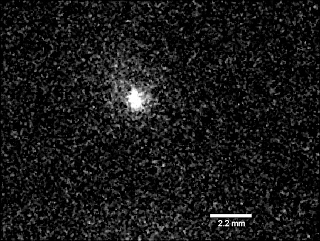 |
The focused spot of the beam profile. The Einzel focusing
lens will focus particles with a specific charge-to-mass ratio
into a beam as seen |
Hi Everyone,
 |
The halo of the beam profile. Due to the non-constant
charging process in the source, the charge-to-mass ratio of
each particle can vary greatly. This leads to this unfocused
halo around the focused spot. |
We're still working hard over here at CCLDAS so unfortunately we've been neglecting the blog a little bit. Some updated info on the accelerator, we've finally got a preliminary image of what the beam actually looks like going down the accelerator. We put a window and foil as close to the source of the accelerator as we could and we ended up with these images of that foil. Unfortunately, as you can see, our beam is pretty defocused right now. Luckily we do expect a central beam plus a diffuse halo around it, which is what we see. The only problem is that we want that central beam to be more like 1mm than 15, so we've got a bit of work to do.
The reason for the central beam and the halo has to do with the way the dust source works. This particular source does not charge every particle the same, so the charge-to-mass ratio is not constant across all the particles. The focusing of the beam on the other hand, is dependent on the charge-to-mass ratio. What we would expect is that a majority of the particles will be charged to the same charge-to-mass ratio, giving you a well focused central beam, but then the rest of the particles will end up in the diffuse halo around the central focus.
I'll be continuing these studies into next week and hopefully will have more updates for you by then.
Shu





 The dust position sensor (DPS) is finished and ready to give the position of its first dust particles during a test run in the small accelerator tomorrow. Similar to the dust trajectory sensor (DTS), DPS reads the pulses from induced charges on a grid of wires as a charged particle flies through. Comparing the pulses from each wire allows us to pinpoint the position of the particle. Unlike the DTS, the DPS is small enough to fit inside the beamline and can be placed in a number of locations.
The dust position sensor (DPS) is finished and ready to give the position of its first dust particles during a test run in the small accelerator tomorrow. Similar to the dust trajectory sensor (DTS), DPS reads the pulses from induced charges on a grid of wires as a charged particle flies through. Comparing the pulses from each wire allows us to pinpoint the position of the particle. Unlike the DTS, the DPS is small enough to fit inside the beamline and can be placed in a number of locations.








